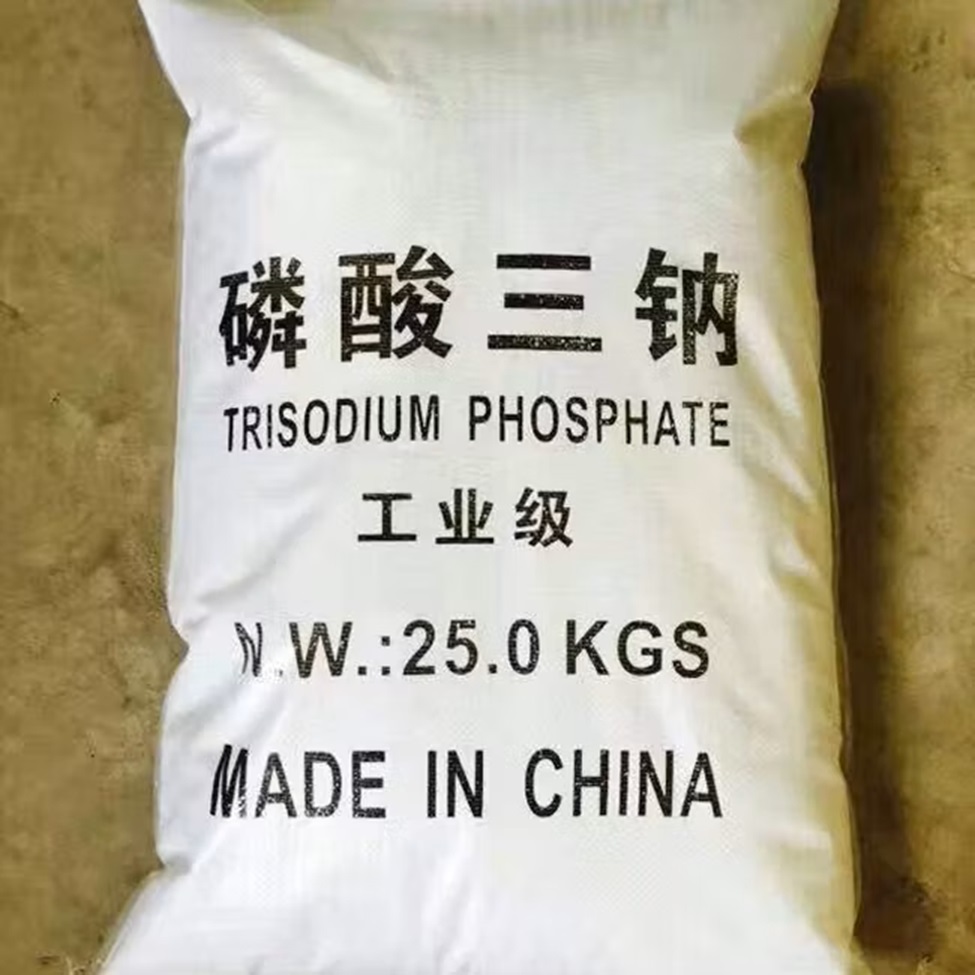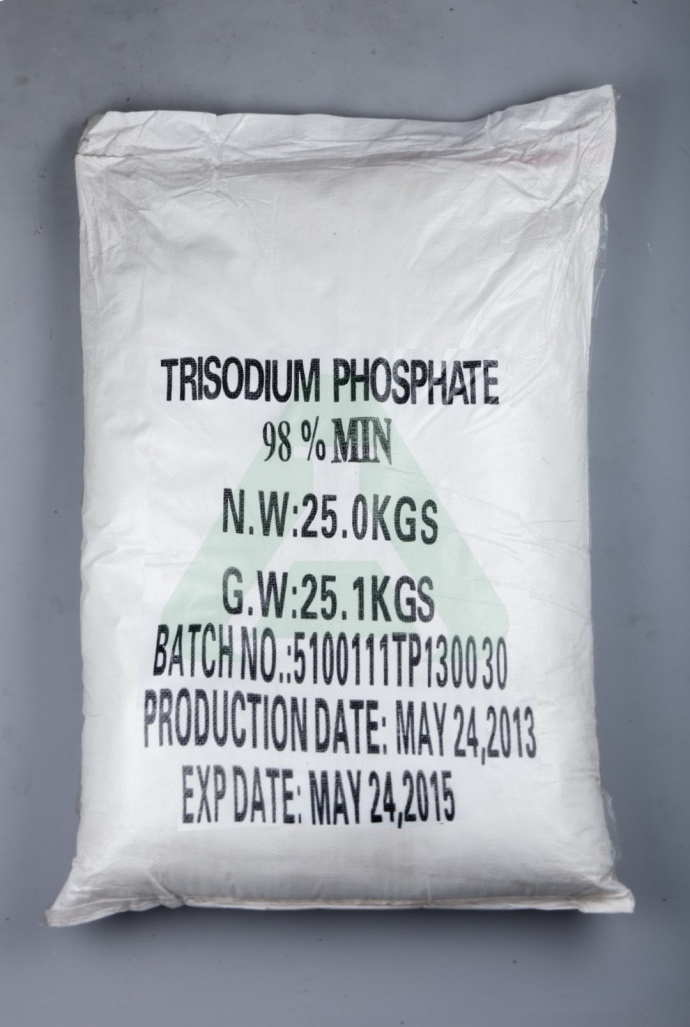We unleash your business potential by maximize the business innovation.
Send EmailTrisodium phosphate anhydrous, Sodium phosphate, trisodium phosphate, TRI-SODIUM ORTHOPHOSPHATE, TSP, TSPA, ATSP, TSPC, 7601-54-9
CAS: 7601-54-9;7632-05-5
Molecular Formula: Na3O4P
Names and Identifiers
| Name | trisodium phosphate anhydrous |
| Synonyms | TSP TSPA ATSP TSPC oakite dri-tri antisal4 nutrifosstp Sodium phosphate trisodium phosphate Tri-Sodium Phosphate TRI-SODIUM ORTHOPHOSPHATE phosphoric acid, sodium salt trisodium phosphate anhydrous |
| CAS | 7601-54-9 7632-05-5 |
| EINECS | 231-509-8 |
| InChI | InChI=1/3Na.H3O4P/c;;;1-5(2,3)4/h;;;(H3,1,2,3,4)/q3*+1;/p-3 |
Physico-chemical Properties
| Molecular Formula | Na3O4P |
| Molar Mass | 163.940671 |
| Density | 2.536 g/cm3(Temp: 17.5 °C) |
| Melting Point | 1340°C |
| Water Solubility | Soluble in water. Insoluble in ethanol and carbon disulfide. |
| Solubility | Soluble in water (121 mg/ml at 20 °C). |
| Vapor Presure | 0Pa at 20℃ |
| Appearance | Colorless crystal |
| Color | White |
| Merck | 14,8662 |
| PH | 10.95(1 mM solution);11.71(10 mM solution);12.12(100 mM solution) |
| Storage Condition | Inert atmosphere,Room Temperature |
| Sensitive | Hygroscopic |
| MDL | MFCD00003510 |
| Physical and Chemical Properties | Character: white crystal. melting point 1340 ℃ relative density 2.536g/cm3 solubility soluble in water, its aqueous solution is alkaline. Insoluble in alcohol. |
| Use | Used as water softener, boiler scale remover, metal rust inhibitor, sugar juice purification agent |
Risk and Safety
| Risk Codes | R34 - Causes burns R36/37/38 - Irritating to eyes, respiratory system and skin. |
| Safety Description | S26 - In case of contact with eyes, rinse immediately with plenty of water and seek medical advice. S36/37/39 - Wear suitable protective clothing, gloves and eye/face protection. S45 - In case of accident or if you feel unwell, seek medical advice immediately (show the label whenever possible.) S24/25 - Avoid contact with skin and eyes. |
| UN IDs | UN 3262 8/PG 3 |
| WGK Germany | 1 |
| RTECS | TC9490000 |
| FLUKA BRAND F CODES | 34 |
| TSCA | Yes |
| HS Code | 28352910 |
| Hazard Class | 8 |
| Packing Group | III |
| Toxicity | LD50 skin in rabbit: > 300mg/kg |
7601-54-9 - Nature
colorless to white crystalline or crystalline powder, odorless. General goods have anhydrous and twelve hydrate two. Dodecahydrate melting point of 73.4 deg C, the relative density of d2911 62. It is heated to 55-65 °c to form decahydrate, heated to 60-100 °c to form hexahydrate, heated to above 100 °c to form monohydrate, and heated to above 212 °c to form anhydrate. Soluble in water (28.3g/lOOmL), insoluble in ethanol. In dry air, it is easy to be deliquescent and weathered to form sodium dihydrogen phosphate and sodium bicarbonate. In water is almost completely decomposed into disodium hydrogen phosphate and sodium hydroxide, 1% of the aqueous solution pH value of 11.5~12.1.
Preparation Method
by phosphoric acid and soda ash neutralization reaction to generate disodium hydrogen phosphate, and then neutralized by caustic soda, refined. It can also be prepared by the neutralization reaction of thermal phosphoric acid with caustic soda, cooling crystallization, separation and drying.
Use
used as a quality improver in food processing. The complexing metal ions, pH value and the effect of increasing the ionic strength of the food can be increased, thereby improving the adhesion and water holding capacity of the food. China's provisions can be used for cheese, the maximum use of 5g/kg; In Western ham, meat, fish, shrimp and crab in the maximum use of 3G/kg, in cans, fruit juice, the maximum usage in beverages and dairy products was 0. 5g/kg.
Safety
- woodchuck oral LD50: greater than 2g/kg. ADI O ~ 70mg/kg (total phosphate in terms of phosphorus, FAO/WHO,2001). GRAS (FDA,& sect;182, 1778,& sect;182, 5778,& sect;182, 2000).
- should be stored in a cool, ventilated, dry warehouse, pay attention to moisture and avoid heating. They shall not be co-stored with moist and toxic substances. Transport should be protected from rain and sun exposure. When loading and unloading, handle with care to prevent packaging damage. Packed in polypropylene woven bags lined with polyethylene plastic bags, each with a net weight of 50kg. The words "Avoid Heat" and "prevent moisture" shall be printed on the package. Fire, can use water, sand, all kinds of fire extinguishing.
Reference Information
| Use | as a water retention agent in the food industry, used in canned foods, fruit juices, dairy products, meat products, cheese and drinks. In the chemical industry, textile, printing and dyeing, paper making, power generation and other industries used as water softener and detergent, Boiler Scale Inhibitor, water softener in paper dyeing, the production of wax paper adhesive pH buffer, dye fixing agent, mercerization enhancer for fabrics, anti-embrittlement agent for thread making. The metallurgical industry is used for chemical degreasing, decontamination, and as an excellent accelerator in photographic developing solutions. Detergent for teeth cleaners and bottles. Coagulant of rubber milk. Sugar juice purification agent. solid trisodium phosphate (TSP) belongs to strong alkali and weak acid salt, with strong alkalinity and high solubility, stable chemical properties, and can be stored for a long time in the containment spray System (EAS) the addition of TSP instead of NaOH in the spray water can adjust the pH value of the spray liquid, effectively remove the iodine gas released from the leaked cooling water to the containment, and avoid the injury of strong alkali to the staff, easy to clean after an accident. as a quality improver, there is an effect of increasing the complexing metal ions, pH, ionic strength, etc. of a food, thereby improving the adhesion and water holding capacity of the food. China's regulations can be used for cheese, the maximum use of 5g/kg; In Western ham, meat, fish, shrimp and crab in the maximum use of 3.0g/kg; In canned foods, fruit juice, the maximum amount used in beverages and dairy products was 0.5g/kg. used as analytical reagent and water softener, Also used for the purification of sugar used as water softener and detergent, Boiler Scale Inhibitor, dye fixing agent, fabric mercerization enhancer, metal corrosion inhibitor or rust inhibitor. Enamel industry used as flux, decolorizing agent. Used in leather industry as fat-removing agent and degumming agent. used as water softener, boiler scale remover, metal rust inhibitor, sugar juice purifier, etc. |
| solubility in water (g/100ml) | grams dissolved per 100ml of water at different temperatures (℃): 4.5g/0 ℃;8.2g/10 ℃;12.1g/20 ℃;16.3g/30 ℃;20.2g/40 ℃; 20.9g/60 ℃;60g/80 ℃;68.1g/90 ℃;77g/100 ℃ |
| hazard | trisodium phosphate is non-hazardous and is a general chemical. Its aqueous solution is strong alkaline, if the chemical reagent Na3PO4 is directly dissolved in water, its strong alkaline is corrosive, but the medical Na3PO4 concentration is very small, can be an injection, treatment of neurodermatitis, chronic eczema. When trisodium phosphate is used for export, there will be a cargo transport condition assessment report. The identification results show that trisodium phosphate is not susceptible to explosion, is not flammable, does not belong to oxidants and organic peroxides, not belonging to toxic and Transmissibility substances, non-radioactive, non-corrosive, no other risk. but too much sodium phosphate can damage the mucous membranes, upper respiratory tract, eyes, and skin. Inhalation may be fatal due to spasm, inflammation and edema of the larynx and bronchi, chemical Pneumonia or pulmonary edema. After exposure caused a burning sensation, Cough, wheezing, laryngitis, shortness of breath, Head Pain, Nausea and vomiting. Food additives, if excessive: Not only will damage the various nutrients in food, but also serious harm to human health, in the human body for a long time will be caused by a variety of diseases, such as tumor lesions, bleeding gums, angular cheilitis, neuritis and affect offspring deformation and genetic mutations, and even damage to the liver function. |
| production method | spray drying method trisodium phosphate dodecahydrate crystals are added to the dissolution tank with l0%~ 15% water, heat to 85~95 ℃, stir and dissolve, then purify the solution, pump the refined solution to the metering tank, and spray it through the atomizer, spray drying is carried out under the conditions that the guide angle of atomization steam is 30 °, the pressure of atomization steam is 0.15~0.3 Mpa, the inlet temperature is 650~750 ℃, and the outlet temperature is 140~170 ℃, the finished product of anhydrous trisodium phosphate was obtained. The Hot phosphoric acid method consists of the neutralization reaction of hot phosphoric acid with caustic soda, and the product is obtained by cooling, crystallizing, centrifuging and drying the neutralization solution. H3PO4 + 3NaOH → Na3PO4 + 3H2O extraction phosphoric acid method at 90~100 ℃, neutralization and extraction of phosphoric acid with industrial soda ash to 50% ~ 70% of the acid is converted to sodium phosphate, sodium fluosilicate is precipitated, filtered, the filtrate is further neutralized with soda ash to slightly alkaline (pH 8.4~8.6); Then neutralized with sodium hydroxide solution to form trisodium phosphate, and filtered while hot, the clear liquid is concentrated to a relative density of 1.24~1.26(28~30 ° Bé), and then cooled to 25~70 ° C for crystallization; The product is centrifuged and dried, and the mother liquid can be reused. Na2CO3+H3PO4→Na2HPO4+H2O+CO2↑Na2HPO4+NaOH→Na3PO4+H2O |



